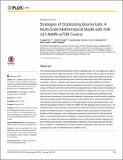Files in this item
Strategies of eradicating glioma cells : a multi-scale mathematical model with miR-451-AMPK-mTOR control
Item metadata
| dc.contributor.author | Kim, Yangjin | |
| dc.contributor.author | Powathil, Gibin | |
| dc.contributor.author | Kang, Hyunji | |
| dc.contributor.author | Trucu, Dumitru | |
| dc.contributor.author | Kim, Hyeongi | |
| dc.contributor.author | Lawler, Sean | |
| dc.contributor.author | Chaplain, Mark | |
| dc.date.accessioned | 2015-09-18T09:40:03Z | |
| dc.date.available | 2015-09-18T09:40:03Z | |
| dc.date.issued | 2015-01-28 | |
| dc.identifier | 206440173 | |
| dc.identifier | a5276527-f288-4605-867d-f40853567686 | |
| dc.identifier | 84961289886 | |
| dc.identifier.citation | Kim , Y , Powathil , G , Kang , H , Trucu , D , Kim , H , Lawler , S & Chaplain , M 2015 , ' Strategies of eradicating glioma cells : a multi-scale mathematical model with miR-451-AMPK-mTOR control ' , PLoS One , vol. 10 , no. 1 , e0114370 . https://doi.org/10.1371/journal.pone.0114370 | en |
| dc.identifier.issn | 1932-6203 | |
| dc.identifier.other | RIS: urn:D077304928562D76A63772CFFA006762 | |
| dc.identifier.other | ORCID: /0000-0001-5727-2160/work/55379009 | |
| dc.identifier.uri | https://hdl.handle.net/10023/7503 | |
| dc.description.abstract | The cellular dispersion and therapeutic control of glioblastoma, the most aggressive type of primary brain cancer, depends critically on the migration patterns after surgery and intracellular responses of the individual cancer cells in response to external biochemical and biomechanical cues in the microenvironment. Recent studies have shown that a particular microRNA, miR-451, regulates downstream molecules including AMPK and mTOR to determine the balance between rapid proliferation and invasion in response to metabolic stress in the harsh tumor microenvironment. Surgical removal of main tumor is inevitably followed by recurrence of the tumor due to inaccessibility of dispersed tumor cells in normal brain tissue. In order to address this multi-scale nature of glioblastoma proliferation and invasion and its response to conventional treatment, we propose a hybrid model of glioblastoma that analyses spatio-temporal dynamics at the cellular level, linking individual tumor cells with the macroscopic behaviour of cell organization and the microenvironment, and with the intracellular dynamics of miR-451-AMPK-mTOR signaling within a tumour cell. The model identifies a key mechanism underlying the molecular switches between proliferative phase and migratory phase in response to metabolic stress and biophysical interaction between cells in response to fluctuating glucose levels in the presence of blood vessels (BVs). The model predicts that cell migration, therefore efficacy of the treatment, not only depends on oxygen and glucose availability but also on the relative balance between random motility and strength of chemoattractants. Effective control of growing cells near BV sites in addition to relocalization of invisible migratory cells back to the resection site was suggested as a way of eradicating these migratory cells. | |
| dc.format.extent | 30 | |
| dc.format.extent | 6250402 | |
| dc.language.iso | eng | |
| dc.relation.ispartof | PLoS One | en |
| dc.subject | QA Mathematics | en |
| dc.subject | NDAS | en |
| dc.subject | SDG 3 - Good Health and Well-being | en |
| dc.subject.lcc | QA | en |
| dc.title | Strategies of eradicating glioma cells : a multi-scale mathematical model with miR-451-AMPK-mTOR control | en |
| dc.type | Journal article | en |
| dc.contributor.institution | University of St Andrews. Applied Mathematics | en |
| dc.identifier.doi | 10.1371/journal.pone.0114370 | |
| dc.description.status | Peer reviewed | en |
This item appears in the following Collection(s)
Items in the St Andrews Research Repository are protected by copyright, with all rights reserved, unless otherwise indicated.

